Guide to Antarctic Bear: As a new additive manufacturing technology, cold aerodynamic spraying (cold spraying) has a broad application prospect in the field of material processing. Cold spraying is a powder deposition method that utilizes the self-consolidation ability of solid powder particles to achieve the combination of particles. Under the condition of high-speed impact, the self-consolidation of this powder can be achieved. With the research of cold spraying process equipment and spraying process, some shortcomings of cold spraying have been gradually overcome, and its application field has gradually expanded. There are also relevant technology application companies in China, which have started to go public. For details, see "Cold Spraying Metal 3D Printing Repairs the Landing Gear Girder of Fighter, Business Explosion quadruples, and Hubei Chaozhuo Aviation Technology Co., Ltd. plans to launch an IPO of Science and Technology Innovation Board".
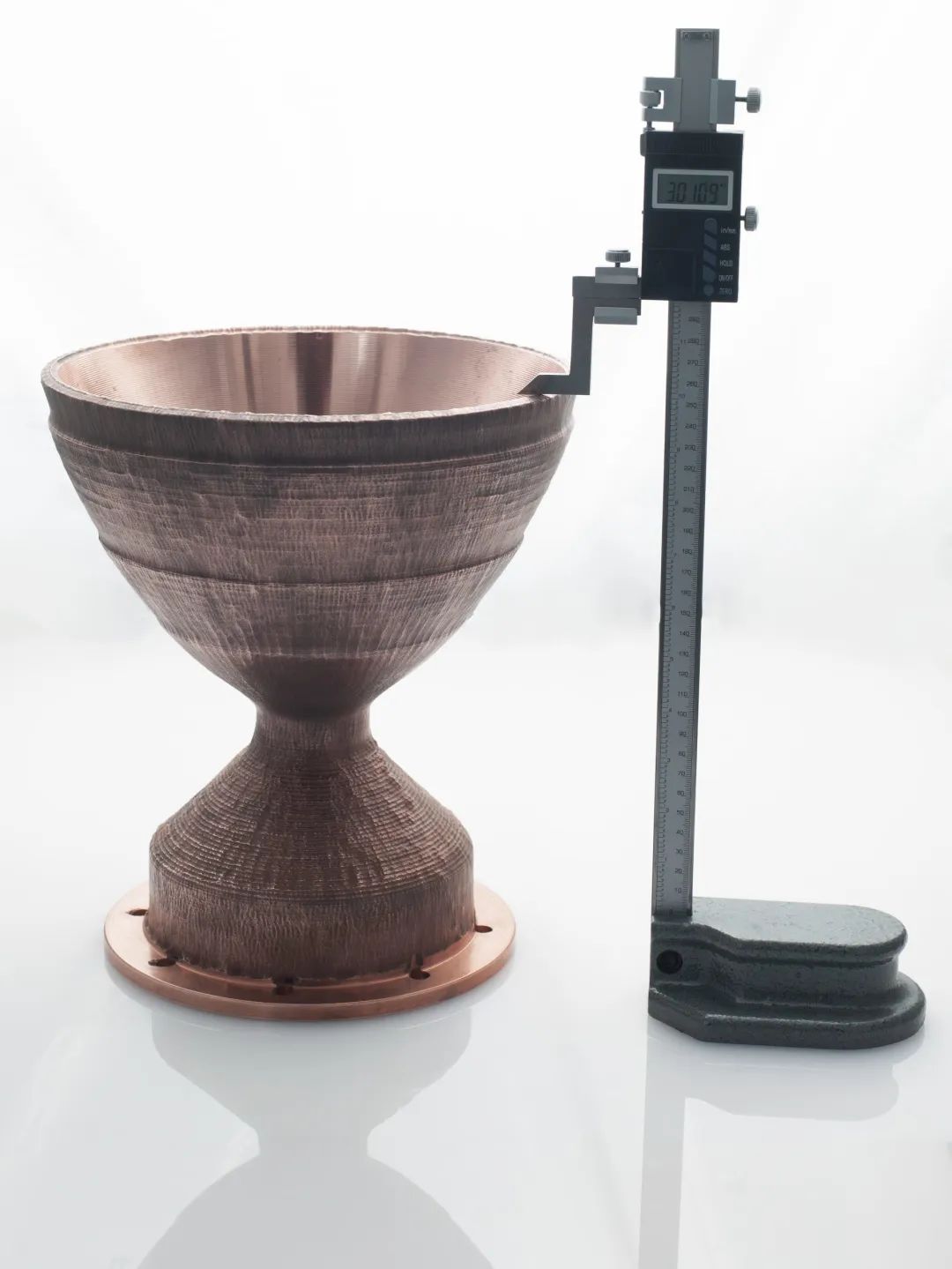
This issue of the Antarctic Bear article summarizes the cold spraying 3D printing technology and its coating deposition principle, summarizes the research status, application status, patent application status, development direction and application prospect of the cold spraying metal 3D printing technology at home and abroad in recent years, with a view to providing a reference for readers to further understand and learn about the professional knowledge of the cold spraying metal 3D printing.
Cold spraying technology
Cold spraying technology is a coating preparation method invented by Papyrin and others of the Institute of Theoretical and Applied Mechanics of the former Soviet Academy of Sciences in the middle and late 1980s. It is found that when the powder spraying speed exceeds a certain critical value, the powder will deposit and form a coating on its surface after collision with the substrate. Therefore, they put forward the concept of cold spraying in 1990 and published the first paper on cold spraying. Subsequently, cold spraying technology has gradually attracted people's attention due to its advantages in preparation, and has developed rapidly in the field of material surface coating preparation technology. At the same time, researchers also carried out research on the development of cold spraying equipment, coating deposition principle, coating structure and performance, which played a positive role in promoting the development and application of cold spraying technology.
Cold spraying technology is a new spraying technology based on the principle of aerodynamics, which uses compressed gas to drive the powder particles to accelerate through the Laval scaling nozzle, so that the supersonic powder particles collide with the substrate to produce plastic deformation and deposit on the substrate surface to form a coating. According to the difference of spray pressure and powder delivery method, the cold spraying equipment can be divided into high pressure (1.5~4.0MPa) and low pressure (0.6~1.5MPa) cold spraying. The high-pressure cold spraying equipment system mainly uses N2, He or the mixture of the two gases as the gas source, and its high-pressure gas path and powder flow pipeline are independent. The spraying powder enters from the front end of the zoom nozzle, and after mixing with the hot gas flow inside the nozzle, it is accelerated to spray out through the zoom nozzle. The equipment system is relatively large, and is mostly fixed; In addition, the spray temperature of the equipment is relatively high (200~800 ℃), and the spray powder speed can reach 300~1200 m/s; The coating has high deposition rate, uniform and dense structure, which can realize rapid preparation of large area coating; But at the same time, there are also shortcomings such as large consumption of gas and powder, high economic cost of spraying and difficult handling of equipment.
Compared with the high-pressure cold spraying equipment system, the low-pressure cold spraying equipment system is simple and portable. The spraying powder enters from the rear section of the zoom nozzle, and the accelerated and heated gas drives the powder to spray out; The gas pressure required by the spraying equipment is small, and compressed air is mostly used as the carrier gas. The spraying temperature (200~650 ℃) is low, the spraying powder speed is about 350~700m/s, the gas consumption is small, and the spraying cost is low. It can be used for coating preparation and additive repair of damaged parts; However, there are also shortcomings such as low bonding strength and low deposition rate of the coating. The structure diagram of high-pressure and low-pressure cold spraying equipment system is shown in the figure below.
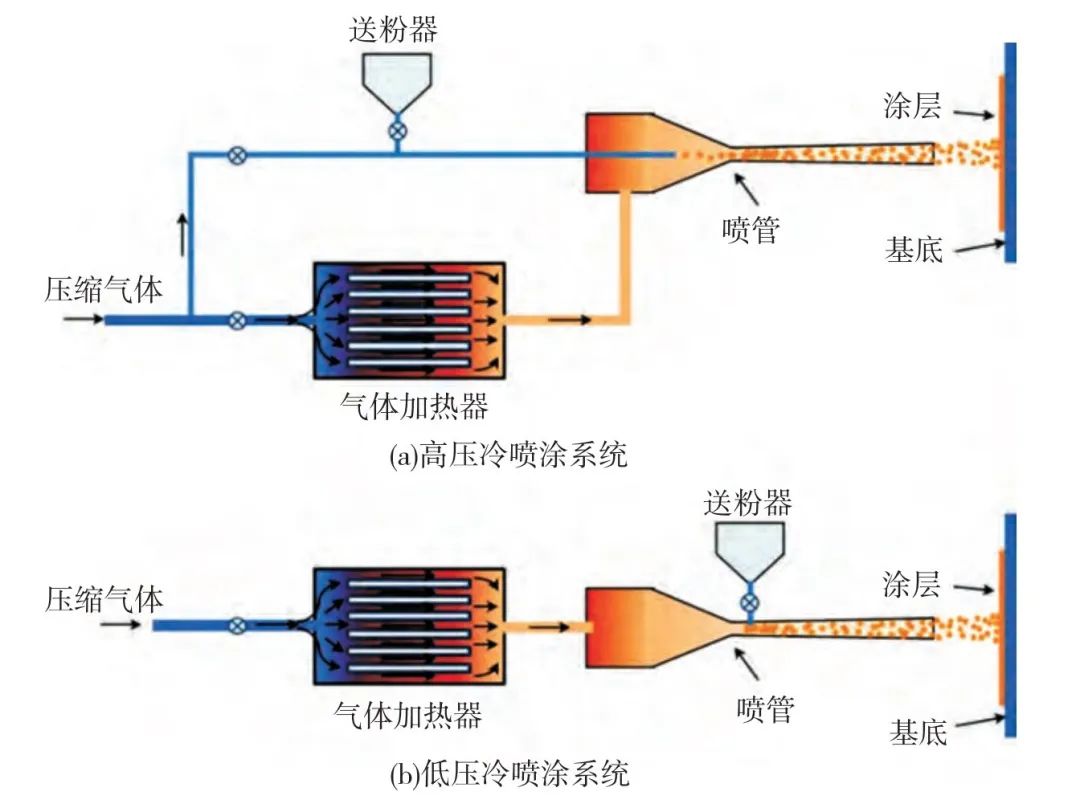
△ Structure diagram of high/low pressure cold spraying equipment system
In addition, the coating preparation technology gradually developed on the basis of the original cold spraying technology includes vacuum cold spraying, pulse gas cold spraying, laser-assisted cold spraying, shock wind tunnel cold spraying and electric field assisted cold spraying.
Deposition principle of cold spraying coating
In the process of studying the deposition principle of cold spraying coatings, the occurrence of adiabatic shear instability of materials becomes an important prerequisite for effective deposition of coatings. As ⁃ sadi et al. studied the stress, strain and temperature changes of the interface when copper powder collided with the substrate at different spraying speeds and deposited during the cold spraying process by combining numerical simulation and experiment, and analyzed the deposition principle of the coating. The results show that too high or too low spray powder speed will cause erosion or rebound, and the coating deposition cannot be achieved; Only when the speed of the sprayed powder reaches or approaches its critical deposition speed, the heat generated by the high-speed collision between the sprayed powder and the substrate surface can not be dissipated in time, resulting in sudden changes in the stress, strain and temperature of the impact interface, which increases the plastic deformation of the copper powder and realizes the effective deposition of the coating. In addition, due to the difference in the deposition state of different powders during the spraying process, the bonding modes between particles in the coating during the adiabatic shear instability process can be divided into physical bonding, mechanical bonding, metallurgical bonding and chemical bonding formed by different particles due to the temperature rise of the interface during the high-speed collision process.
During the deposition process of cold spray coating, the spray powder particles undergo plastic deformation under the impact of mechanical impact, and the deformation increases the dislocation density of the powder particles, refines the interface grains, effectively hinders the relative movement between atomic layers, and significantly improves the hardness and strength of the coating. In addition, researchers can also improve the mechanical and tribological properties of the coating by adding large particle size powder and hard ceramic particles to the metal spraying powder, while using its mechanical impact to increase the plastic deformation of metal particles, and also through dispersion strengthening. For example, the role of hard ceramic particles in the deposition process of cold spraying coating can be divided into four stages: (1) the acceleration of hard ceramic particles on metal powder and the preferential collision of some hard particles on the surface of the substrate material; (2) The hard ceramic particles remove the oxide layer on the substrate surface by impact to obtain an activated and rough surface of the substrate material; (3) Hard ceramic particles rebound after impacting the coating, and a small amount of ceramic particles are deposited in the coating; (4) The density of the coating increases under the continuous impact of hard ceramic particles, and some ceramic particles break and rebound after collision. The schematic diagram of its action process is shown in Figure 2.
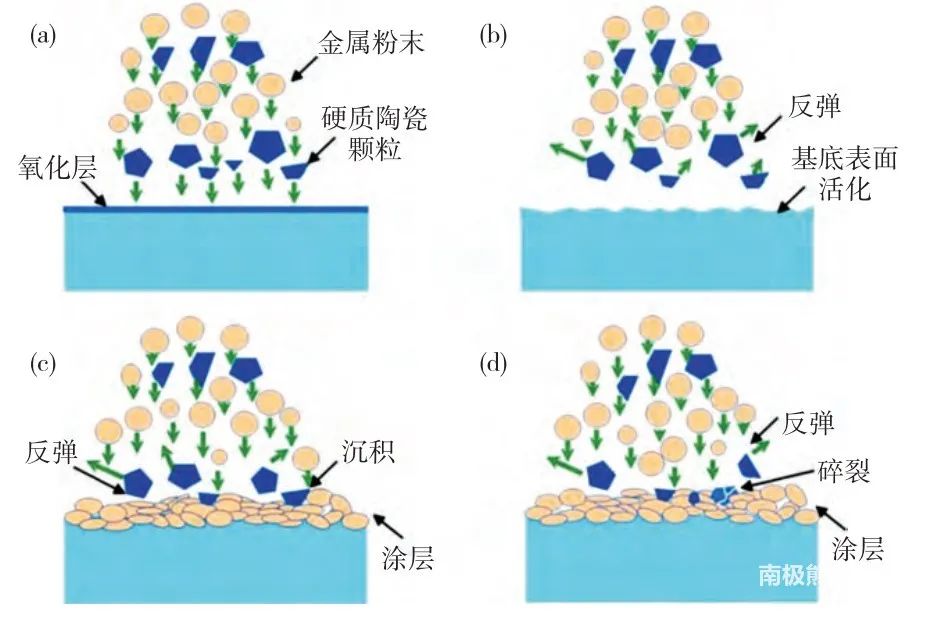
△ Schematic diagram of action process of hard ceramic particles in the deposition process of cold spraying coating
Bonding mechanism of cold spray coating
In the literature related to cold spraying, researchers revealed the bonding mechanism of particles/particles and particles/matrix through experimental observation, such as metallurgical bonding, mechanical anchoring, mechanical interlocking and interface mixing. Metallurgical bonding is the amorphous intermediate layer containing intermetallic compounds formed due to dynamic recrystallization caused by heteroepitaxy or superplasticity (adiabatic shear) under large strain rate. Mechanical anchoring means that particles attach to the substrate and produce weak indentation on the substrate to ensure the anchoring of particles. This phenomenon is common to the deposition of metal particles on the surface of ceramic substrate. Mechanical interlock is a phenomenon that particles are embedded in the substrate due to the large depth of penetration into the substrate. It is often found in the combination of metal/polymer, oxide/polymer, ceramic/metal and metal/metal. This kind of mechanical interlock can also be extended to the deformation of particles deposited in the defects on the surface of the substrate, and can also be used to explain the continuity of the material at the interface when soft metal particles are deposited on the harder substrate, such as the combination of soft metal/polymer, metal/ceramic and polymer/metal. In the process of interface mixing, the bonding mechanism is controlled by the development of the interface vortex that makes the particles and the matrix mix at the interface.
Application and research status of cold spray additive manufacturing technology (CSAM) at home and abroad
In theory, the cold spraying technology can prepare almost all metal and metal/ceramic composite coatings with a thickness of more than 50 pm, and the cold spraying deposition layer can effectively prevent high temperature, corrosion, corrosion, oxidation and chemical corrosion. At present, it has a wide range of applications in aerospace, automotive, energy, medical, ocean and other fields and shows unique advantages in the field of additive manufacturing technology.
Yao Jianhua of Zhejiang University of Technology proposed supersonic cold spray coupled laser 3D printing
In 2016, Professor Yao Jianhua of Zhejiang University of Technology in China, in order to break through the main bottleneck of the industrial application of 3D printing and strengthen the "production, study, research and application", focused on the new 3D printing technology of "supersonic cold spraying+laser", put forward the "basic research of metal additive manufacturing (3D printing) technology based on supersonic laser deposition", and combined it with laser cladding to give play to their respective advantages.
Akron University applies for the technical license of "cold spraying 3D printing maintenance aircraft"
In March 2017, Akron University in Ohio, the United States, cooperated with Aviation Maintenance Engineering Services (AMES) to explore how to better use the "cold spraying technology" to repair aircraft metal parts, and submitted the relevant license application to the Federal Aviation Administration.
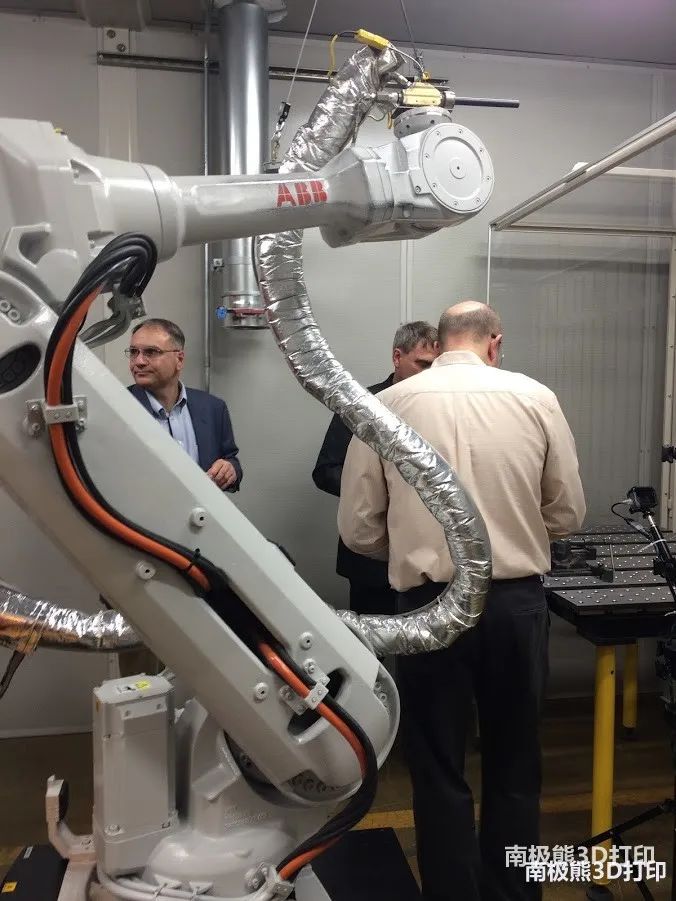
Titomic developed a new metal 3D printing process based on cold spraying - KineticFusion
In September 2017, Australia's Titomic Company, together with CSIRO (Commonwealth Scientific and Industrial Research Organization of Australia), applied the cold spraying technology to the manufacturing field and developed a new 3D printing process - "KineticFusion". KineticFusion process is carried out in a closed chamber. The metal powder is accelerated to 1.5-3 times of the sound speed by high heat gas, and then shot out from the spray gun through a nozzle. In this way, the powder particles will collide with each other on the target surface, and firmly combine with each other mechanically through a plastic deformation process. Among them, the spray gun is precisely controlled by the mechanical arm, so it can spray according to the established pattern very accurately.
In September 2018, Titomic announced an agreement with TAUV to use Titomic's 3D printing technology to produce titanium alloy solid soldier unmanned aerial vehicles (UAVs) and apply cold spraying technology to the 3D printing of titanium alloy parts.
In March 2021, Titomic Company and Türkiye's machine tool industry and trade company Repkon signed an agreement to jointly establish a new 3D printing production facility in Australia, which is used to manufacture weapon launch tubes designed by Repkon and manufactured using Titomic's KineticFusion (TKF) 3D printing technology. The new factory will use Repkon's unique flow forming ability and Titomic rapid additive manufacturing TKF process to produce high-performance launch tubes. In November of the same year, Titomic announced the acquisition of its competitor, DycometEurope, a Dutch cold spraying technology company. This transaction strengthened the global influence of Titomic, integrating the new base in Europe, the headquarters in Australia and the American subsidiary of Titomic. Through DycometEurope, a healthy customer order channel has been brought to the whole European continent. This transaction will also provide a direct source of revenue for Titomic.
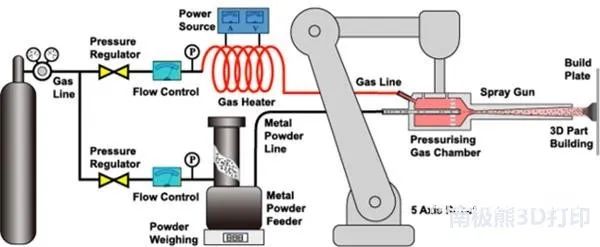
△ KineticFusion process schematic diagram
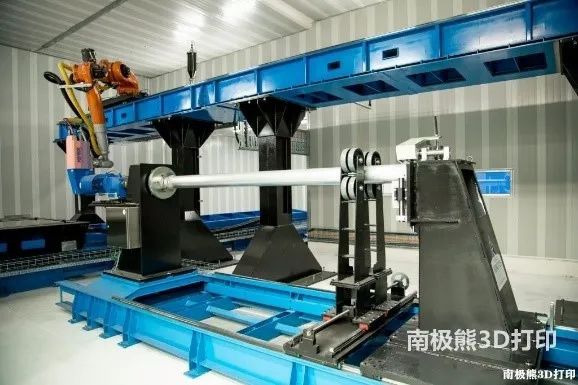
△ Titomic's ultra-large cold spraying metal 3D printer can achieve 9mx3mx1.5m metal parts
Professor Li Wenya of Western Polytechnic University summarized the manufacturing technology of "cold spraying+" composite additives
In May 2019, Professor Li Wenya, School of Materials, Northwestern Polytechnic University, published a review paper in the top journal of the welding field, "Cold spray+'as a new hybrid manufacturing technology: characterization review", aiming to discuss and solve the scientific problems of weak metallurgical bonding and poor plasticity at the interface of cold spray deposition. Due to the inherent deposition characteristics of cold spraying, that is, each particle undergoes severe plastic deformation and deposition to form a coating, the combination of particle interface and mechanical combination are dominant, and there is a small amount of metallurgical combination, resulting in poor plasticity of cold spraying deposition. In response to this scientific problem, Professor Li Wenya put forward the concept of "cold spray+", that is, the processing and manufacturing technologies such as cold spray composite post-heat treatment, laser, shot peening, friction stir processing, hot rolling and hot isostatic pressing to enhance the metallurgical bonding of the interface of the deposit and improve the strength and plasticity of the deposit; At the same time, cold spray coating, as a strengthening coating, has been used to improve the strength and plasticity of friction stir welding, brazing, fusion welding joints, and significantly improve the fatigue life of the coated substrate.
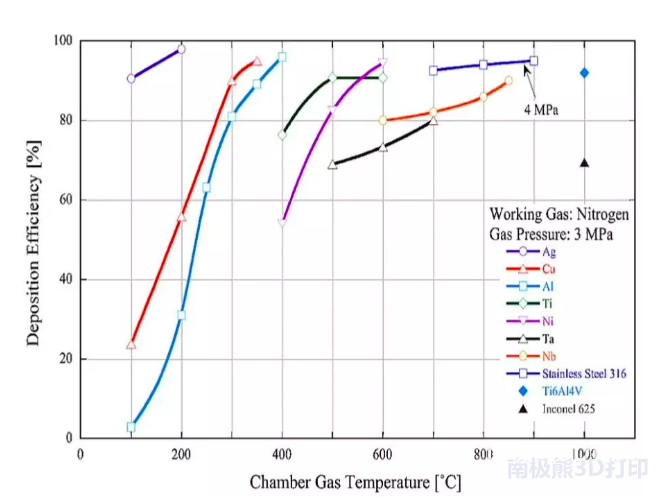
△ The influence of the types of materials that can be prepared by cold spraying and the gas temperature on the deposition efficiency
NRC and Polycontrol start cold spraying additive manufacturing research facility
In July 2019, the National Research Council of Canada and Polycontrol, an engineering solution company headquartered in Quebec, jointly established a research institute to support manufacturers and researchers in researching, adopting and deploying cold spraying additive manufacturing technology. The research center studies various forms of surface treatment, coating and 3D accumulation through cold spraying. They also study advanced technologies such as local laser heat treatment, in situ robot processing and surface treatment.
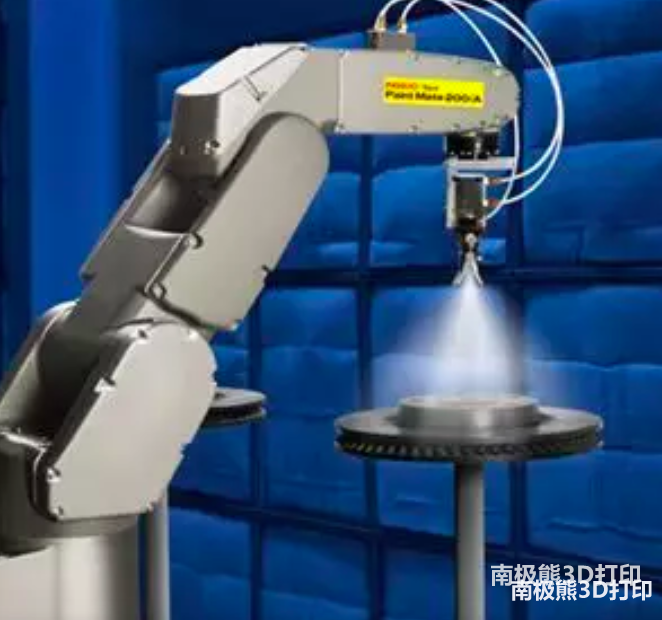
SPEE3D cold spraying metal 3D printer is hot in the military
In June 2020, the Australian Army conducted field tests on the WarpSPEE3D Additive Manufacturing (AM) system of metal 3D printer manufacturer SPEE3D. In August of the same year, a second round of field exercises was conducted. Using SPEE3D's patented cold jet 3D printing technology, the Army can create components in a fast and cost-effective way. Facts have proved that the WARPSPEE3D system can print large metal parts weighing up to 40 kg, and print at the speed of 100 grams per minute, even at 37 ℃ and 80% humidity.
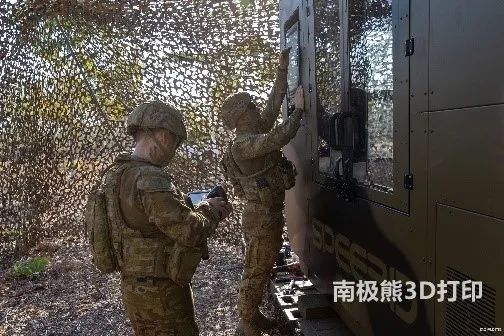
△ The Australian Army is preparing to operate the WarpSPEE3D printer
On July 8, 2021, SPEE3D announced that it had obtained more than 1.5 million Australian dollars (about 7.2741 million yuan) for the low-cost mass production of cold-sprayed metal 3D printing rocket engines. WarpSPEE3D is a large-format metal 3D printer of SPEE3D. Compared with traditional manufacturing, this machine can significantly improve speed, cost efficiency and scalability. The processing speed of SPEE3D is also 100 to 1000 times faster than that of traditional 3D metal printing, becoming one of the fast methods to turn design into usable metal parts.
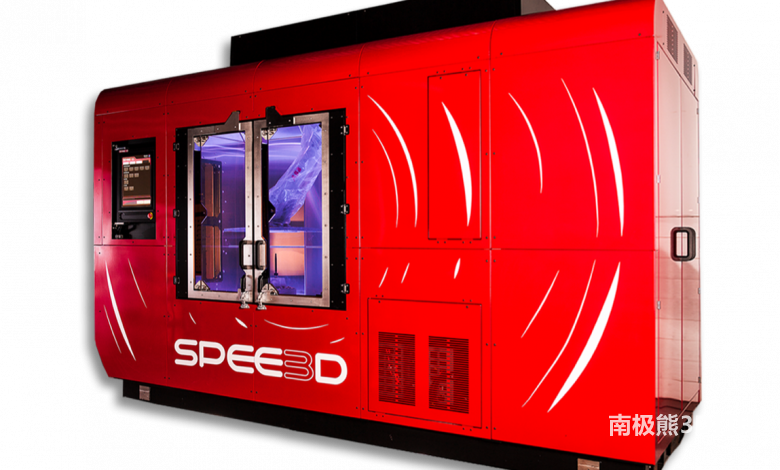
△WarpSPEE3D
In May 2022, SPEE3D's cold spraying metal 3D printing technology was selected by the US Navy to participate in the exercise code-named MaintenX to verify the ability of metal 3D printing technology in actual combat, realize daily maintenance and solve supply chain problems. At the same time, it can also improve the lack of accessories of old ships and repair of war damage.
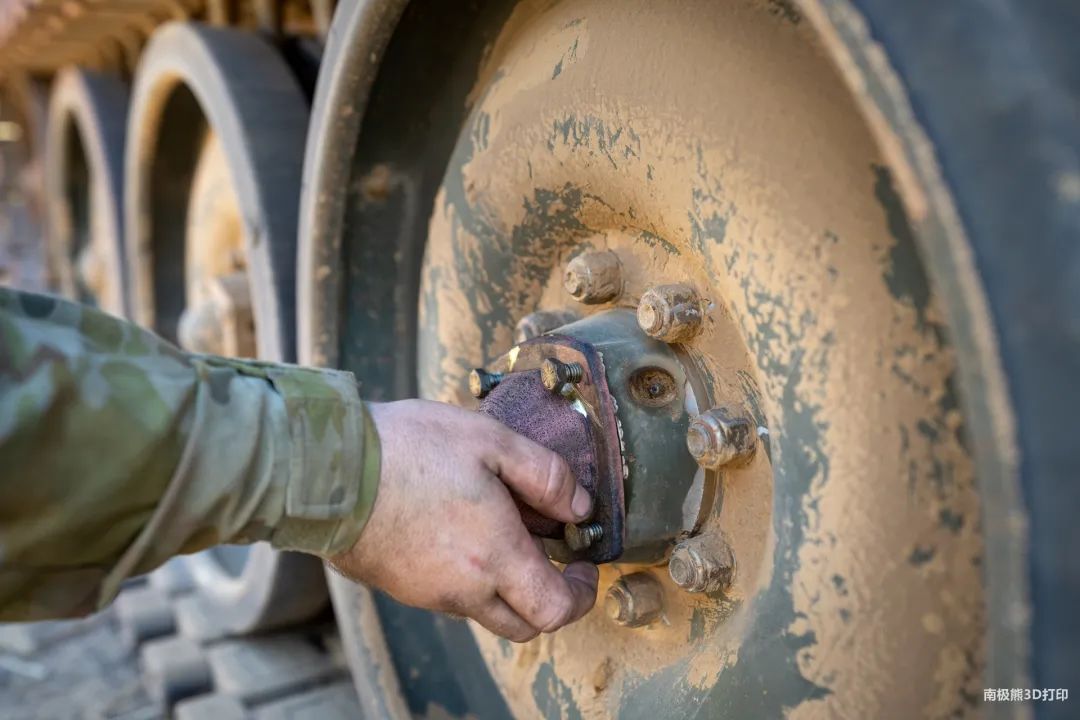
△ 3D printed wheel bearing cover installed on M113. Photo from SPEE3D
Germany ImpactInnovations new generation high-speed cold spraying metal 3D printer EvoCSII
At the beginning of May 2021, German ImpactInnovations released the latest cold spraying system: ImpactEvoCSII. The new equipment uses cold spray additive manufacturing (CSAM) process, which is developed by Impact Innovations and Airborne Engineering Ltd. Capable of manufacturing components with excellent mechanical properties, large size and specific geometric complexity. The new ImpactEvoCSII can parallel up to four impact powder feeders, which is very suitable for mass production. In addition, the machine can also operate two impact spray guns in parallel for double-sided spraying or only to increase capacity. EvoCSII integrates a variety of sensors, data recording and higher-level control systems, and its reliability has been significantly improved compared with previous versions.
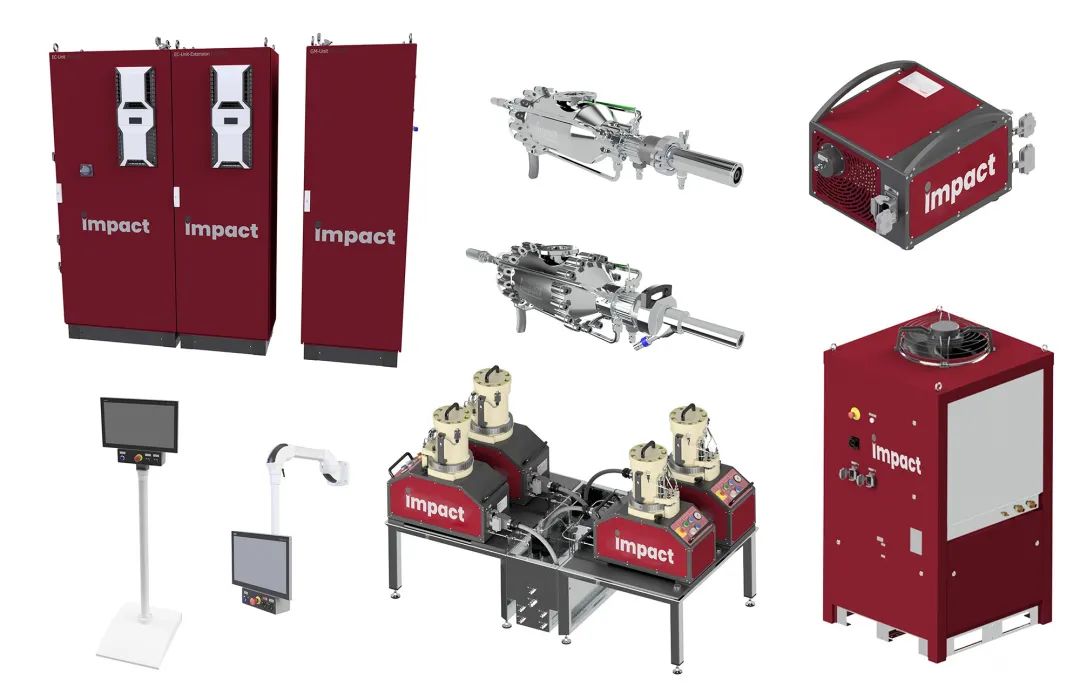
△ ImpactEvoCSII can better conduct on-site monitoring
USAF Repairs Active Aircraft with Cold Spray Technology
In May 2021, the 28th Maintenance Group Additive Manufacturing Flight Team at Ellsworth Air Force Base of the United States repaired an active aircraft for the first time, and used metal cold spraying (kinetic energy consolidation) technology to repair the sliding joint above the B-1B bomber wing, realizing the vertical movement up and down within the wing profile. This is the first application of this technology on active aircraft after its first successful demonstration at the United States Air Force Base in 2019. During the cold spraying process, they use helium to accelerate the particles to Mach 3. 6061 aluminum alloy particles are combined with the base material through impact. It is reported that the maintenance can be completed in hours or days using cold spraying technology, which can enable the Air Force to save about 2 million dollars (about 12.96 million yuan) annually through additive manufacturing technology.
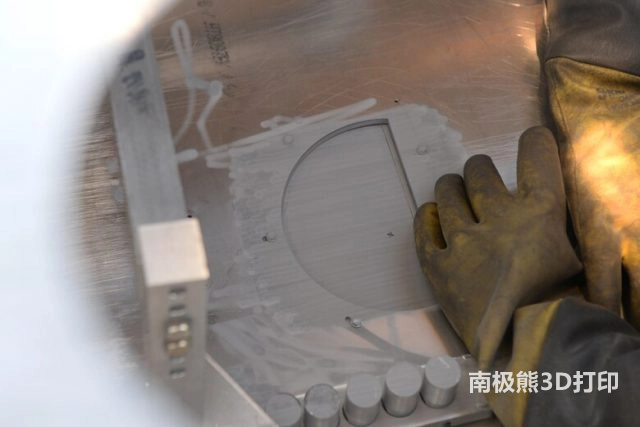
△ The United States Air Force maintains and uses cold spraying to repair aircraft in service
Professor Zou Yu summarized the microstructure evolution and bonding characteristics of metal powder in cold spray additive manufacturing
In November 2021, the AMR of Professor Zou Yu of the University of Toronto, Canada, published a review article "Cold Spray Additive Manufacturing: MicrostructureEvolution and Bonding Features", which focused on the microstructure evolution of four common metals (copper, nickel, aluminum, titanium) during cold spraying, and summarized and sorted out a large number of microstructure characteristics, including recrystallized grains, annealing twins, shear bands, submicron grains Deformation twins and nanocrystals, dynamic recrystallization in cold-sprayed nickel, and grains smaller than 10 nm in cold-sprayed aluminum. The article also introduces the post-treatment heat treatment and nanoindentation characterization of cold spraying materials. Finally, the author proposes to use the old experience for reference, and use new technologies and materials such as machine learning, nano-mechanical testing, and high entropy alloys to promote the research of cold spraying additive manufacturing.
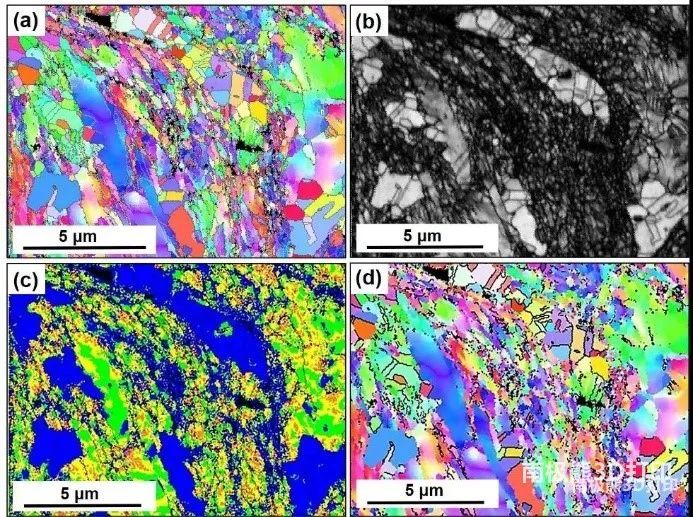
△ EBSD characterization of untreated cold spraying copper material (cold spraying conditions: gas temperature 473K, air pressure 30bar): (a) IPF image, (b) IQ image, (c) KAM image, (d) twin plane boundary image.
Northwest University of Technology explores the microstructure evolution of high entropy alloy produced by cold spraying solid additives
In February 2022, Professor Li Wenya, the State Key Laboratory of Solidification Technology of Northwestern Polytechnic University, and others used cold spray technology to spray micron-scale FeCoNiCrMn particles onto the substrate at a speed of more than 800m/s. Using high-speed impact, the adiabatic plastic deformation process with a strain rate of up to 108~109s-1 was caused, and the severe plastic deformation process of HEA was studied. This study enriches the academic community's understanding of the microstructure and composition evolution of FeCoNiCrMn high entropy alloy under extreme plastic deformation at large strain rate, and provides an important basis for further optimizing the microstructure of FeCoNiCrMn high entropy alloy and improving the mechanical properties in the future using severe plastic deformation conditions.
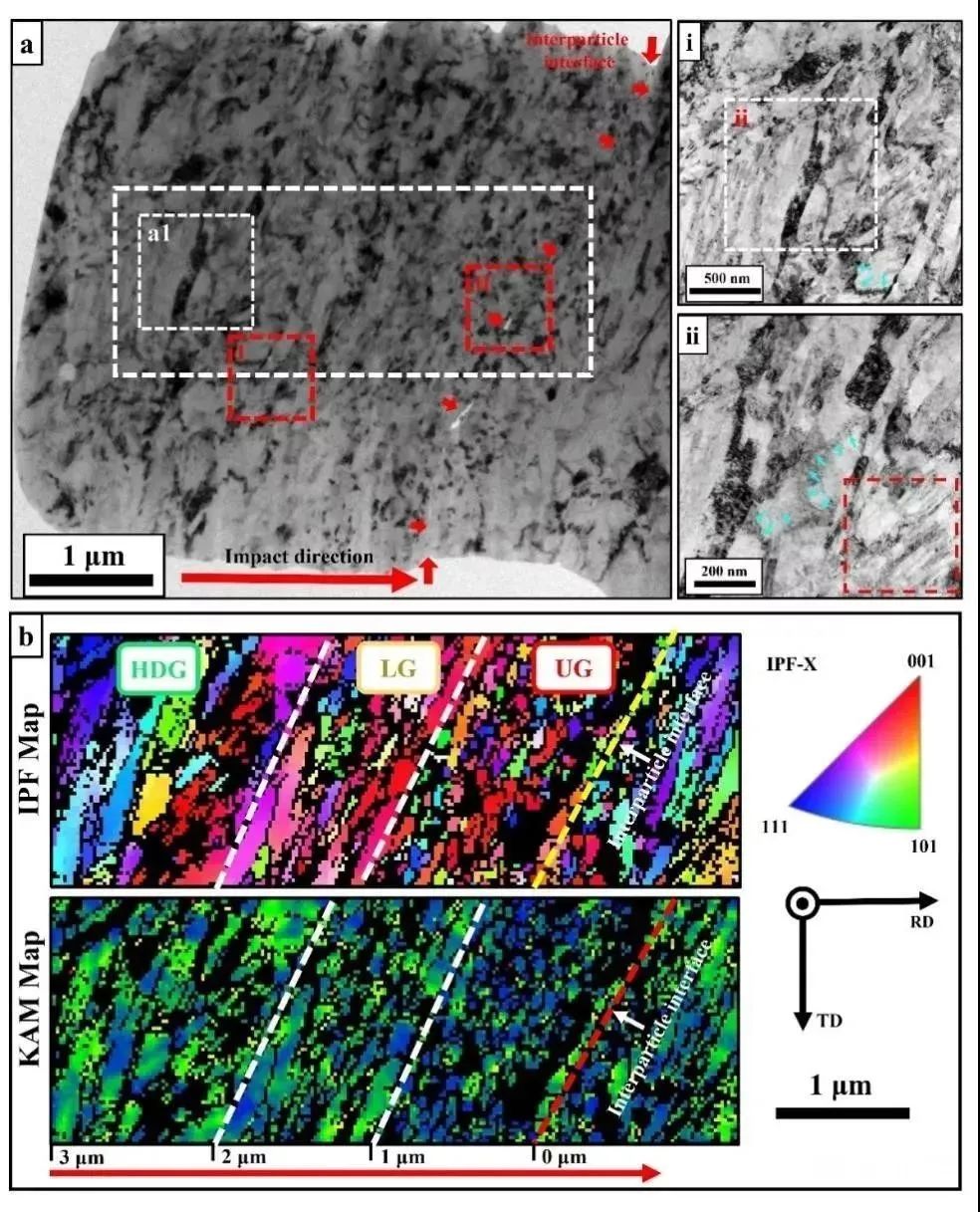
△ Microstructure Analysis of FeCoNiCrMn High Entropy Alloy Deposited by Cold Spraying
Guangdong Institute of New Materials
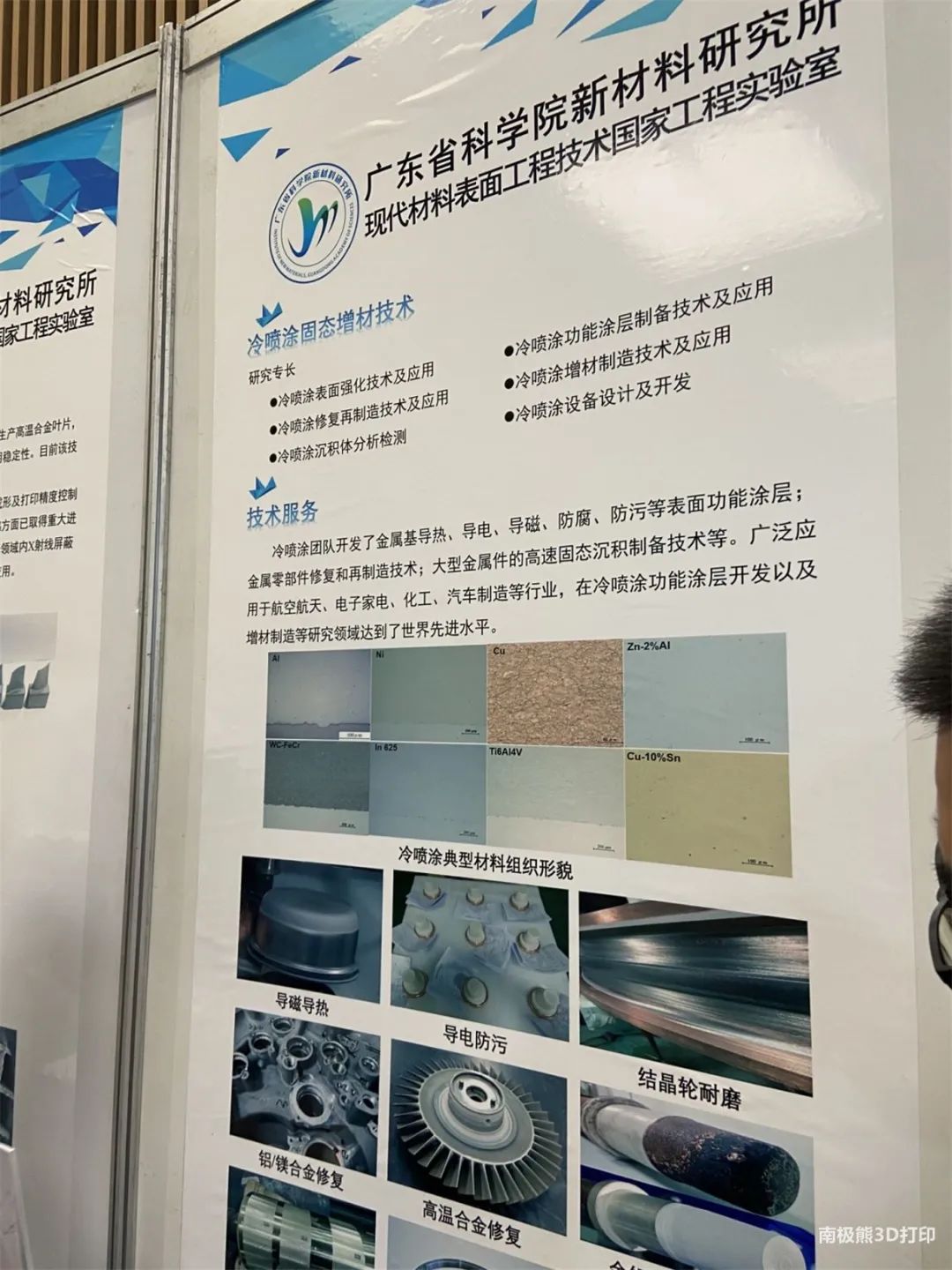
Analysis of cold spraying patent application
Since the concept of cold spraying was put forward by the Soviet Academy of Sciences in 1990, until 2000, the research on cold spraying technology has been in the embryonic stage. At this stage, there are many basic research. Scientific research institutions and companies in other countries have also started the technical tracking and scientific research of cold spraying, and have achieved certain results. The patent application of cold spraying technology has also grown slowly.
In 2001, the first commercial cold spraying prototype was launched by the United States' KTech Company, and ABS Industrial Co., Ltd. also developed its own spraying system. The cold spraying technology began to transition from the basic research stage to the commercialization of the industrial field, and it has been widely used in various fields, which greatly promoted the development of the cold spraying technology. Therefore, the corresponding patent applications have also increased rapidly.
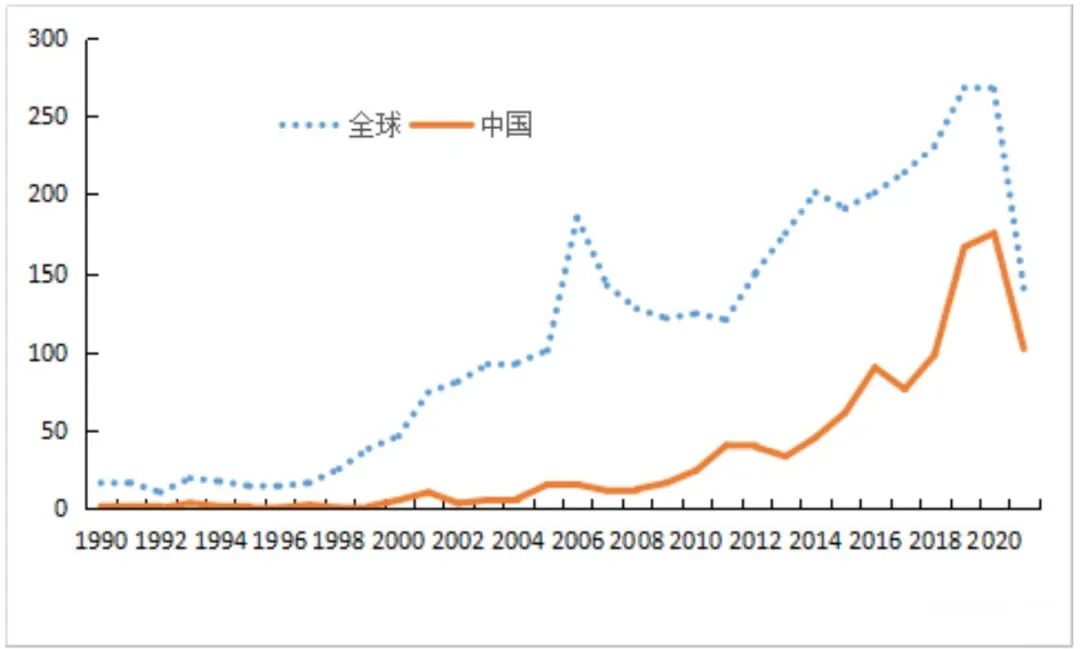
△ The number of global patent applications for cold spraying technology and the number of Chinese patent applications change over time (unit: piece)
In recent years, with the development of new cold spraying technology, the development of more practical cold spraying equipment, and the cross research of different disciplines, the cold spraying technology has been further developed, and its patent application has also been steadily developing. Domestic cold spraying technology developed slowly before 2010 and maintained a steady growth level after 2011.
By comparing the patent applications of cold spraying technology in various countries, it is found that Japan has the highest proportion of patent applications. The main reason is that Japan is one of the countries that studied cold spraying technology earlier, and as early as 2003, it tried to repair the parts of armaments, aviation and navigation with cold spraying technology, and achieved some success. China ranks second in the number of patent applications. Some universities and scientific research institutes have carried out relevant scientific research at an early stage, such as Xi'an Jiaotong University, Dalian University of Technology, Chinese Academy of Sciences, etc., but the main technology is in scientific research institutions, such as Xi'an Jiaotong University, which took the lead in developing the supersonic flame spraying system in 1995, and has also made a lot of research results, The high-performance coating technology developed at the same time has been widely used in various fields. The United States ranks third in the number of patent applications. It has developed the basic device of gas power spraying and the gas power spraying equipment of industrial computer system earlier, and the corresponding scientific research institutions have started the research work of spraying technology optimization earlier.
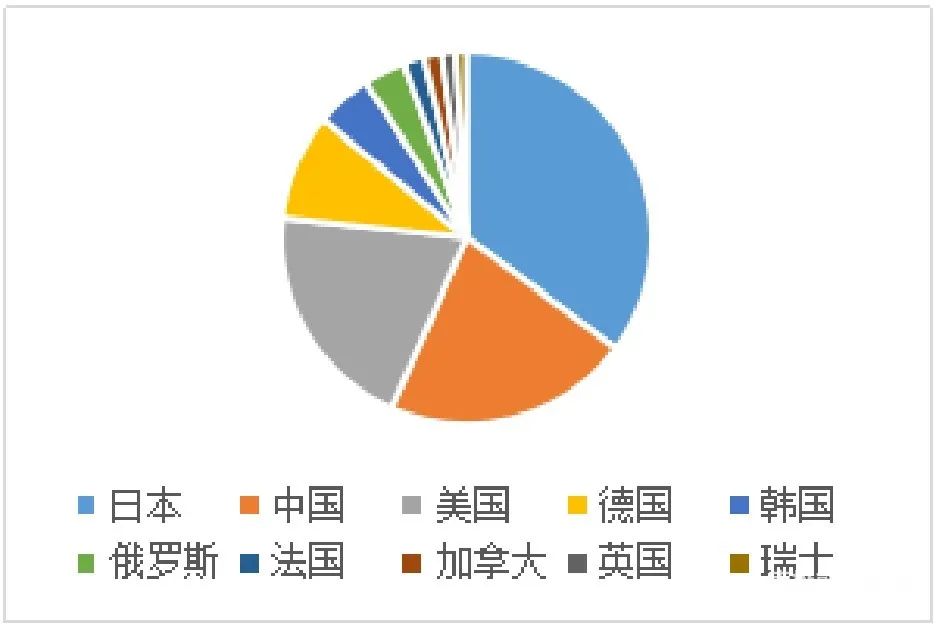
△ Country/region distribution of cold spraying technology patent applicants
The number of patent applications in Germany, South Korea and Russia also accounts for a certain proportion. The ITAM cold spraying device in Russia is the first to be developed and put into actual production. At present, a series of cold spraying devices have been developed; German CGT-Kinetics series cold spraying device is developed on the basis of the device produced in Russia. Its biggest advantage is that the operation is more convenient and the coating quality has been significantly improved; Low-pressure cold spraying equipment has been successfully developed by Russia's Obninsk Powder Spraying Center, etc. Its equipment tends to be miniaturized, and its operation is safe and suitable for on-site operation.
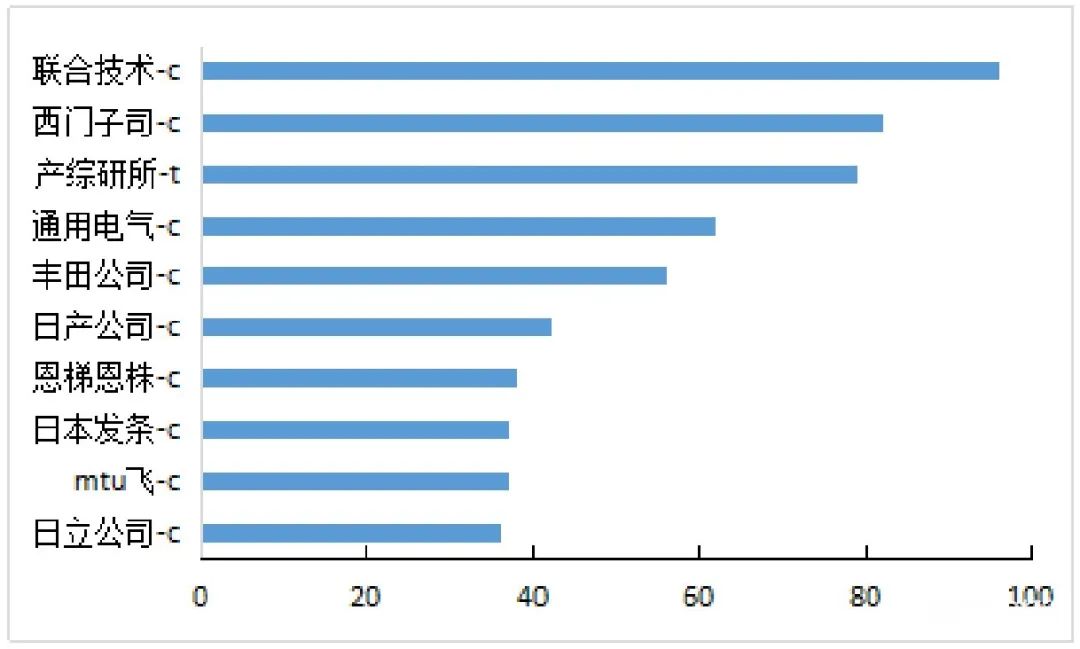
△ Analysis of key applicants for cold spraying technology patents
Development direction of cold spray 3D printing technology
Material diversification
The cold spraying system is mainly divided into two forms: high pressure and low pressure. High pressure cold spraying can provide higher spraying pressure (1.5~5.0MPa) and spraying temperature (up to 1100 ℃), and has a wider range of material selection. The spraying gas uses helium or nitrogen. The gas pressure used for low pressure cold spraying is below 0.8MPa, the particle acceleration effect is poor, and the range of material selection is also limited. Cold spraying powder types include metal, ceramic, polymer and composite powder. The research on cold spraying of metal powder is the first to start. It mainly focuses on copper, aluminum, titanium, magnesium, zinc, tin, tantalum, iron-based, nickel-based, titanium-based, magnesium-based, zinc-based alloys and other steady-state materials. At present, it is developing towards amorphous, quasicrystalline and high entropy alloys and other metastable materials. Due to the low density of polymer powder, low pressure cold spraying is usually used to complete the deposition of polymer materials. The polymer materials used for cold spraying mainly include polyethylene (PE), high-density polyethylene (HDPE), ultra-high molecular weight polyethylene (UHMWPE), fluoroethylene propylene (FEP) and polyamide 12 (PA12). It is difficult to achieve effective deposition of cold sprayed ceramic powder under ordinary cold spraying, which is mostly achieved by vacuum cold spraying, such as hydroxyapatite, TiN, TiO2, etc., which are mostly used in the form of metal/ceramic composite powder. The metal/ceramic composite powder mainly includes Al ⏴ Al2O3, Al ⏴ SiC, Al ⏴ Diamond, Ni ⏴ Al2O3, Cu ⏴ Al2O3, Ni ⏴ WC and Co ⏴ WC. At the same time, the diversification of the base materials has further expanded the application of cold spraying technology, from the metal-metal system to the polymer-metal, ceramic-metal and other systems.
Technology compounding
With the development of diversified material systems, the original process conditions cannot meet the deposition requirements of special materials. Therefore, the development of composite cold spraying technology has become the focus of current research. The Institute of Welding and Coating of Xi'an Jiaotong University has developed the micro-forging assisted cold spraying technology μ 150~200 is added to the metal powder μ About m of in-situ shot-peening particles. The shot-peening particles micro-forge the deposited coating during the spraying process, strengthen the combination between particles and improve the relative density of the coating through compaction. Micro-forging assisted cold spraying technology has unique advantages in the preparation of metal coatings with high hardness and poor plasticity. The laser assisted cold spraying technology has been developed by the laser processing technology engineering research center of Cambridge University and Zhejiang University of Technology. The laser irradiation heating technology is introduced into the cold spraying deposition process. The laser spot and the spray beam are gathered together by adjusting the manipulator, and the particles are preheated twice before the particles are deposited to the substrate, so that the temperature of the particles reaches near the melting point. Compared with normal cold spraying at 900 ℃, the thickness of single coating is 869.5 μ M increased to 1153 μ m. The volume fraction of WC in the coating increased from 23.98% to 29.35%. The laser-assisted cold spraying technology improves the plastic deformation ability of low plastic metal particles through secondary preheating, which is beneficial to the coating preparation of low plastic metal materials. The following figure shows the schematic diagram of micro-forging-assisted and laser-assisted cold spraying technology.
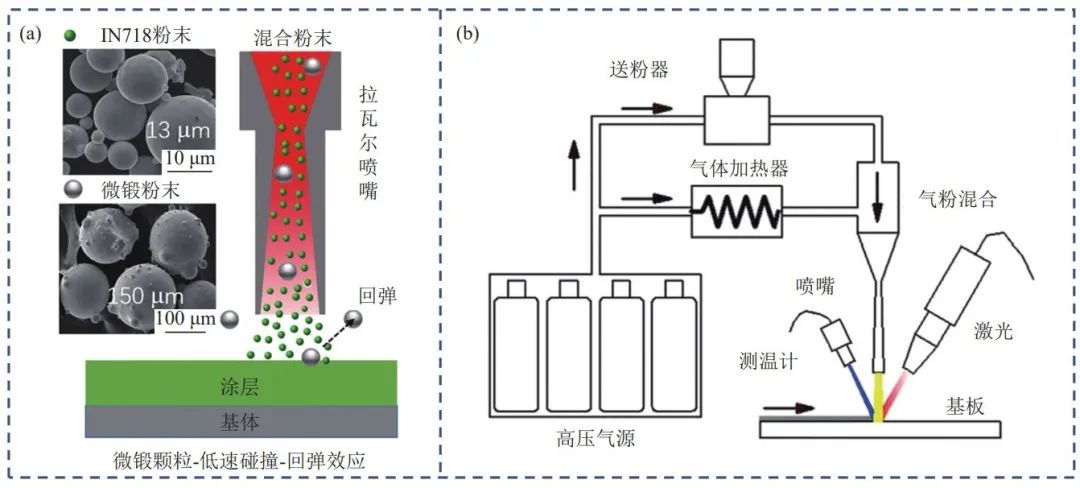
Schematic diagram of in-situ micro-forging-assisted cold spray deposition (a) and schematic diagram of supersonic laser deposition technology (b)
Application high-end
The industrial application of cold spraying technology has always been a problem puzzling the academic community. Due to the problems of poor bonding strength, brittleness of the deposition layer and high air consumption, the cold spraying technology has been limited in its large-scale promotion in the industrial field. At present, the cold spraying technology is mainly applied to military and aerospace equipment. The Ellsworth Air Force Base of the United States uses helium cold spraying to spray 6062 aluminum alloy powder on 2024 aluminum alloy surface. This technology is applied to the maintenance of B-1B strategic bomber fastener hole countersunk hole. The 6061 aluminum alloy was sprayed on the AZ92A magnesium alloy surface by helium cold spraying at the Tinker Air Force Base of the United States for repairing the rear gearbox housing of the TF-33 engine. Inovati, a company based in Santa Barbara, California, USA, uses cold spraying technology to repair military aircraft parts on site, greatly reducing the time required for parts replacement. Moog Company of the United States used cold spraying technology to repair the S-92Sump helicopter, as shown in the figure below. The commercial application of cold spraying technology mainly includes rotating target materials, such as cold spraying rotating titanium aluminum, zinc aluminum, zinc tin, titanium, tantalum, silver, copper, nickel chromium, etc., which are applied in semiconductor, plane display, magnetic storage, glass coating, decorative coating and other fields.
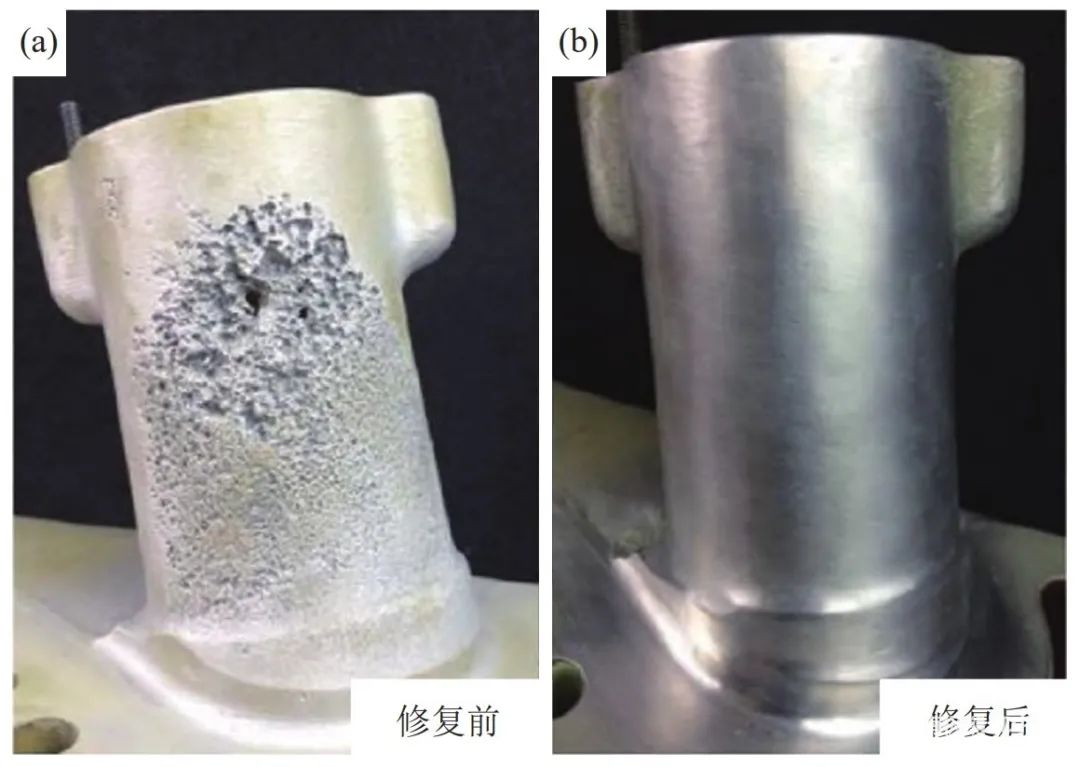
△ Comparison of cold spraying technology before and after remanufacturing: (a) before repair; (b) After repair
Application prospect of cold spraying 3D printing technology
The characteristics of cold spraying at low temperature and high speed make it an economic and environmentally friendly surface treatment technology. The advantages of cold spraying, such as non-oxidation of coating and recyclable particles, cannot be achieved by other spraying processes. At present, the materials of cold spraying have expanded from metal materials with good plasticity to nano-materials, and the ceramic materials that are difficult to achieve deposition will also be slowly applied.
In the future, domestic cold spraying technology still has great room for progress in the following research directions:
Design and optimization of new cold spraying equipment and process. The spray gun is the most important device in the spray equipment. Improving and optimizing the structure of the spray gun is the most economical way to improve the quality of the spray coating, and at the same time, it can also prepare more materials of coating.
Numerical simulation of cold spraying process. The numerical simulation can more intuitively understand the influence of various parameters on the coating quality during the spraying process, and can compare the simulation results with the experimental results to optimize the experimental scheme and verify the existing theories.
A new type of coating is prepared by cold spraying. Expanding the scope of spraying powder, improving the deposition efficiency of spraying powder, and improving the adhesion between coating particles are all the guarantees for preparing new coatings. Although there is some research on this in China, the development of functional coatings such as heat resistant, thermal insulation, medical treatment and lightweight is still less.
Pre-and post-treatment process of cold spraying. The pretreatment of the substrate powder before spraying and the post-treatment of the coating after spraying have a great impact on the final coating quality. The cold spraying coating has poor plasticity, and it is still difficult to prepare the coating with high strength and good plasticity under the proper treatment process.
Repair and additive manufacturing of industrial components. At present, cold spraying has been reported to manufacture parts at home and abroad. Cold spraying can also be applied to the rapid repair of parts, and is expected to achieve the repair of various types of damage, such as cracks, wear, etc.
Antarctic bear 3D printing
|
Prev:None!
Next:None! |
Return |